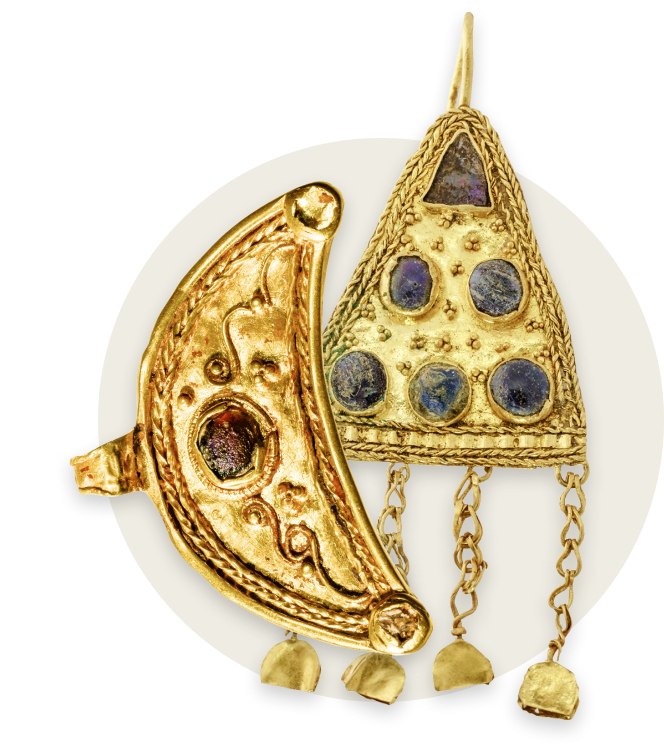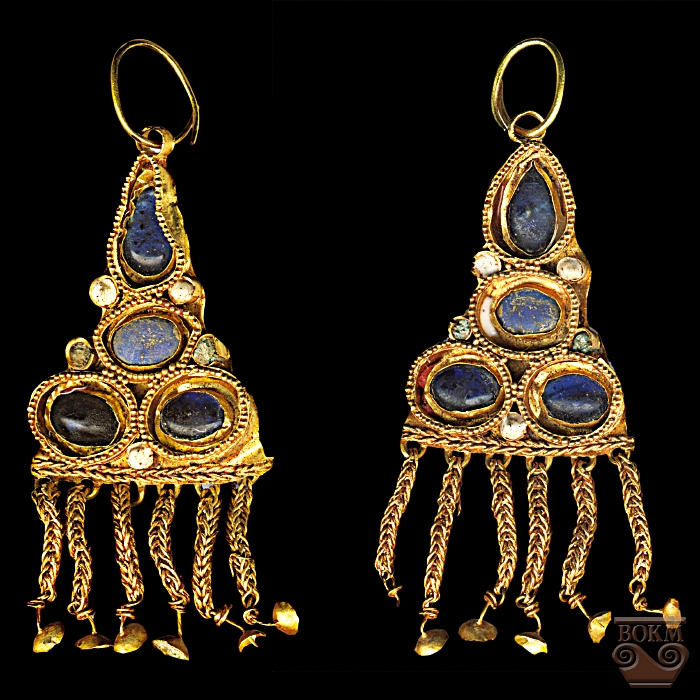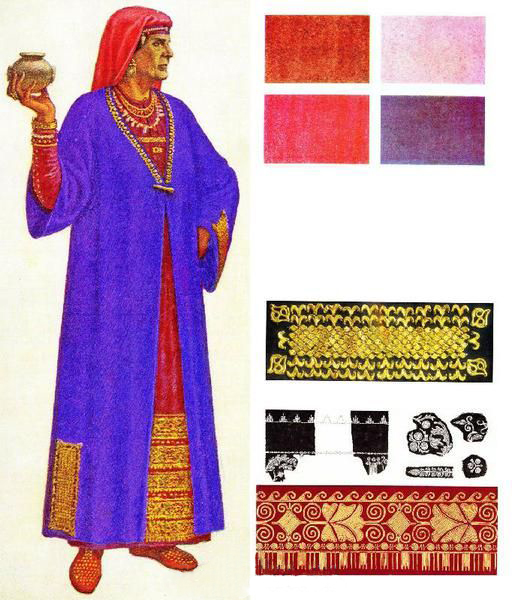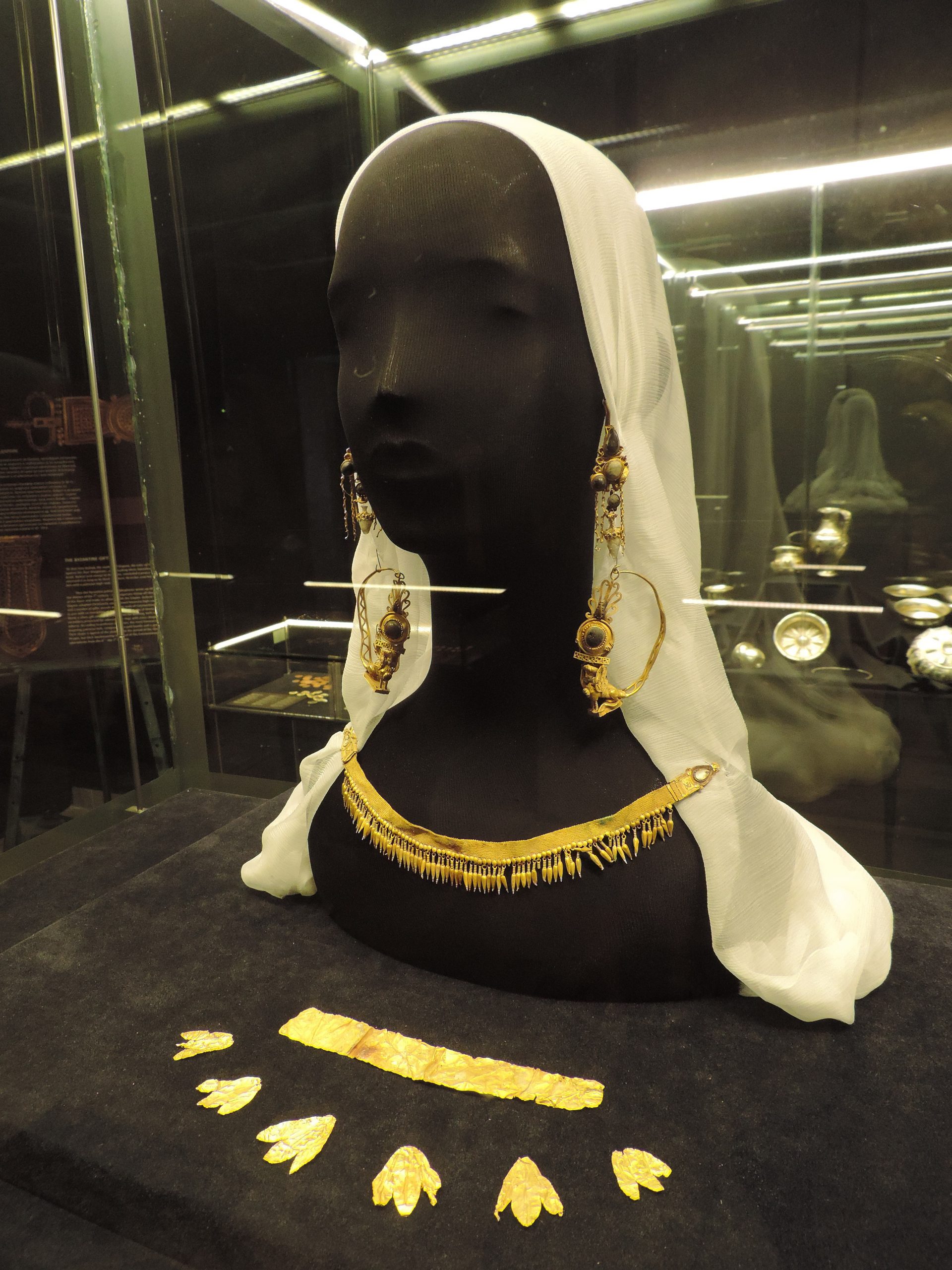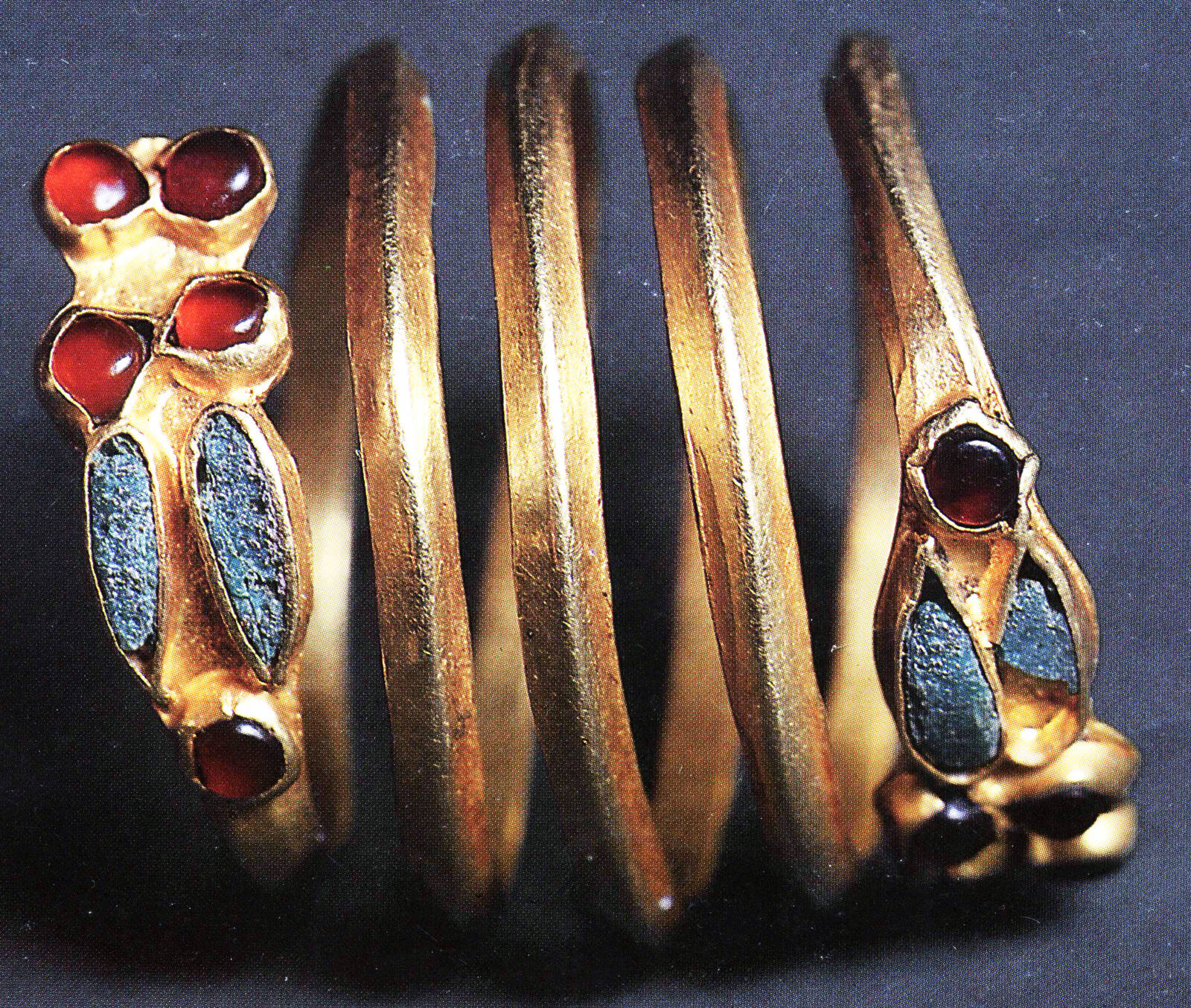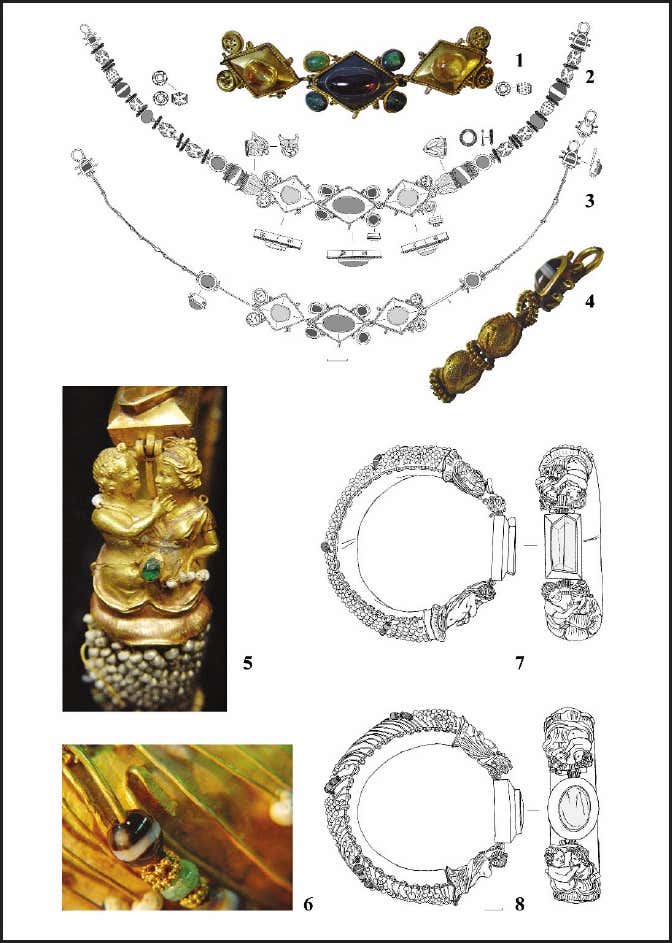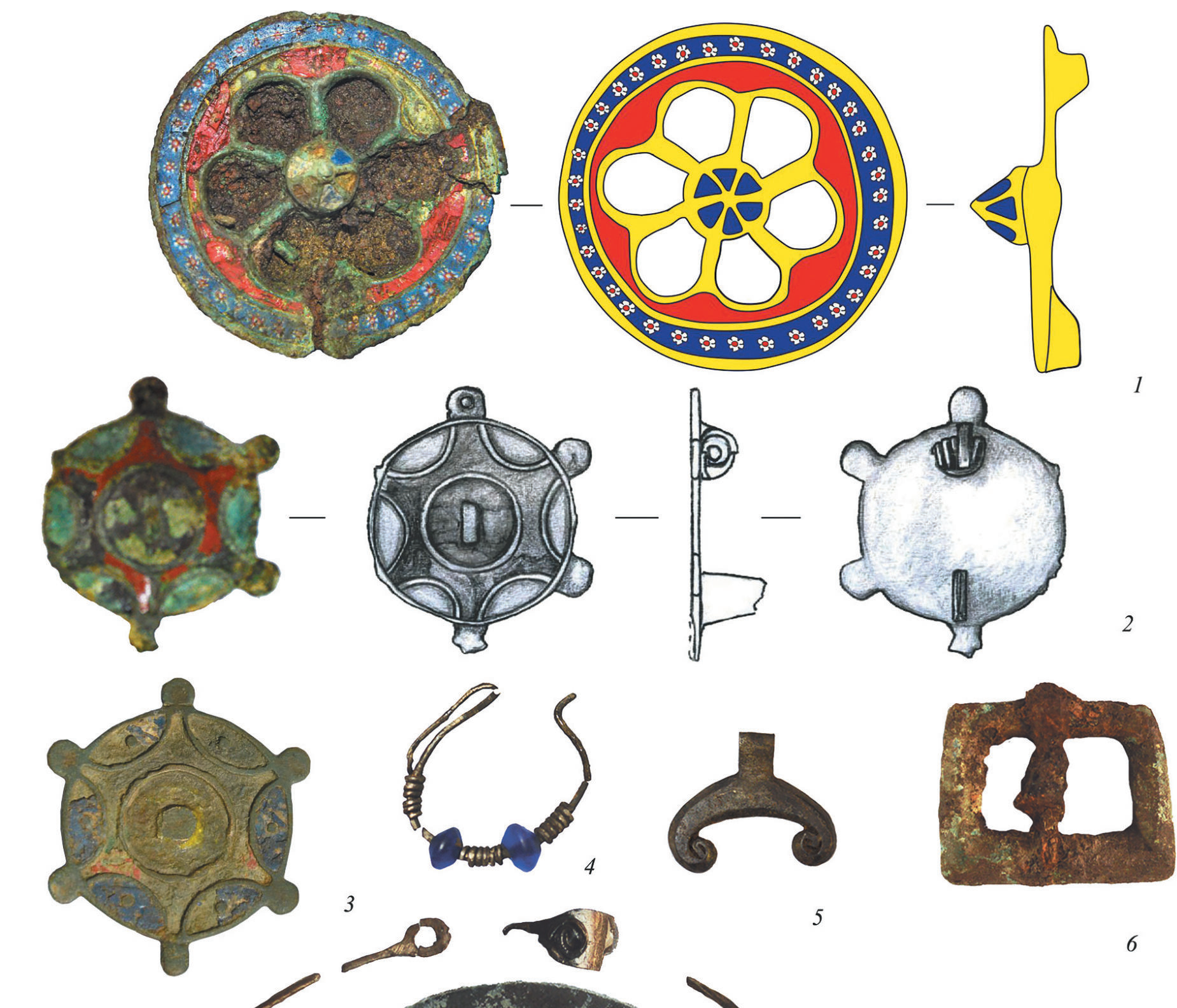“the cemetery of Neyzats [is] located in the central area of the foothills in the Crimean peninsula, Ukraine. Excavations uncovered hundreds of graves from the second to fourth century AD, made by the Sarmatians and Alans.”
The cemetery and the grave goods are widely described by Igor Khrapunov and Anastasiya Stoyanova [see the links in the bottom of the page].
I one of the graves [no. 275] there were found gold earrings inlaid with colorless glass and decorated with the chains ended with the bell-shaped pendants. I quote here detailed description of the earrings by Igor Khrapunov [2013, pp. 51-52]. He also describes other earrings of this type (triangular, lined, decorated with granulation) found in Crimea and dated to the 4th century.
“In the fourth century AD vault no. 275 there was a pair of gold earrings (fig. 48. 5–6), each composed by triangular plate with wire bent like a hook and soldered to its top edge, and four chains finishing with bell-shaped pendants soldered to the lower edge. The border of the face side of the plate is ornamented with wire latticework soldered to it. On the face side are soldered pyramid of six circular sockets with colorless glass insets and granulated triangles in between.
The closest analogy to the earrings from Neyzats is the artefact from the fourth century AD vault in Krasnaya Zorya cemetery in the south-west Crimea. The difference is that the earring from Krasnaya Zarya is the only one and has another number of granulated triangles (Неневоля, Волошинов 2001: 142, рис. 4. 6).
One more pair of analogous earrings was discovered in a vault from the late fourth or early fifth century AD in the cemetery of Suvorovo. Their only difference is the location of fine spheres in the granulated design (Зайцев, Мордвинцева 2003: 58, рис. 3. 1–2).
A little bit different are earrings from grave no. 78 in the cemetery of Sovkhoz 10. They have another location of sockets with carnelian insets and granulated decorations. The publication states that there were carnelian beads hung on chains, though according to the picture these pendants were of metal. In the same grave, there was a coin of Licinius (306–327 AD) (Стржелецкий et al. 2003–2004: 152, табл. 12. 14).
There is burial 1 in barrow 20 of Novoaleksandrovka I cemetery in the Lower Don area from the early stage of the Late Sarmatian period (late second and first half of the third century AD), that contained a pair of gold earrings decorated with insets, wires soldered along the edges, and bell pendants hung on chains. These earrings are considerably different from those published here: their form is trapezium instead of triangle, they have loop for hanging instead of hook, the location of sockets with insets of carnelians and glass paste is different, and the space between the insets are decorated with soldered S-shaped wires instead of granulation (Беспалый 1990: 217, рис. 3. 15). Nevertheless, the similarity between the earrings from Novoaleksandrovka I and Crimean artefacts is big enough to attribute them to the same style.
Sarmatians love to gold earrings with insets and wire pendants appeared as early as the Middle Sarmatian culture (Симоненко, Лобай 1992: 30–31, рис. 19. 1–2; Максименко 1998: 122–123; Засецкая et al. 1999: 53, рис. 4. 6; Морд винцева, Хабарова 2006: 12–13, рис. 3. 4; Пуздровский 2007: 150, рис. 116. 1; 117. 1).
This way, I can draw the conclusion that all the Crimean earrings analogous with Neyzats finds originate from the fourth century AD assemblages. The finds from Neyzats, Krasnaya Zorya and Suvorovo are generally the same, in every case individual features are restricted to the location of granulation. According to the distribution area, these earrings were made somewhere in the Crimea, most likely in Chersonesos. The barbarians were hardly able to make glass insets themselves. The fashion of gold earrings decorated with insets of glass, glass paste or semi-precious stones and pendants on chains originated in the Sarmatian environment as early as the first century AD and did not disappear to the end of the fourth century AD.”
Earrings from a grave nr 275, 4th century, gold, glass.


3–4, 7–10 — knobbed rings;
1 — figurine.
1–3 — grave no. 4; 4 — grave no. 208; 5–6 — grave no. 275; 7 — grave no. 258; 8–9 — grave no. 363; 10 — grave no. 10; 11 — grave no. 25.
Similar earrings from other places


Polychrome earrings [ear pendants / temple earrings] – a triangular plate, decorations made with a wire, bell-shaped pendants with chains

https://ar.culture.ru
Gold pendants from a female burial, part of a headdress.
They are decorated with carnelian, coral and filigree, a pattern made of thin twisted wire. Five gold wire chains are soldered to the base, each of which hangs a bell.
2nd/3rd century
Height 6–6.2 cm. Width 2.7 cm
- Exploring the Cemetery of Nyzats; Igor Khrapunov 2013 https://www.academia.edu
- The Second and the First Half of the Third Century AD Female Costume Accessories in the Cemetery of Neyzats; Anastasiya STOYANOVA in Exploring the Cemetery of Nyzats; pp. 124-165
- Igor N. Khrapunov The Vault with Openwork Plaque from the Cemetery of Neyzats in the Crimea//The Turbulent Epoch. I. New materials from the Late Roman Period and the Migration Period. Lublin, 2008. https://www.academia.edu
- СКЛЕП С ПОГРЕБЕНИЯМИ III – IV вв. н. э. ИЗ МОГИЛЬНИКА НЕЙЗАЦ; Igor Khrapunov 2011 https://www.academia.edu


